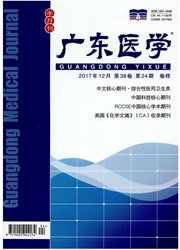

 中文摘要:
中文摘要:
目的探讨紧张性头痛(TTH)与述情障碍之间的关系。方法将收治的60例TTH患者作为TTH组,将同期60例健康体检者作为对照组。比较TTH组与对照组多伦多述情障碍量表(TAS)得分;比较TTH患者中述情障碍者与无述情障碍者的视觉模拟量表(VAS)评分;比较不同性别、年龄等TTH患者TAS总分。结果TTH组患者TAS总分、因子1、因子2得分均高于对照组,两组比较差异有统计学意义(P〈0.05);不同性别、不同职业TTH患者的TAS总分差异有统计学意义(P〈0.05)。根据TAS评分结果,TTH患者中有述情障碍者23例,无述情障碍者25例,两者VAS评分差异有统计学意义(P〈0.05)。结论 TTH患者存在不同程度的述情障碍,这可能影响患者的疼痛感觉,应注重对这部分患者进行及时的心理疏导。
 英文摘要:
英文摘要:
Objective To investigate the correlation between tension -type headache (TTH) and alexithymia. Methods A retrospective analysis of clinical data of 60 TTH patients (TTH group) and 60 health people ( control group) was carried out. Toronto alexithymia scale (TAS) and visual analog scale (VAS) tests were performed. Results The TAS, factor 1 and factor 2 scores were significantly higher in TTH group than those in control group ( P 〈 0. 05 ). There were significant differences in TAS score among TTH patients with different gender and work ( P 〈 0. 05 ). Alexithymia and non- alexithymia were reported in 23 and 25 eases, respectively, in TTH patients, with significant difference in VAS score between them (P 〈0. 05). Conclusion TTH patients have different degree of alexithymia, which may affect the patient's perception of pain, psychological counseling is required to these patients.
 同期刊论文项目
同期刊论文项目
 同项目期刊论文
同项目期刊论文
 期刊信息
期刊信息
